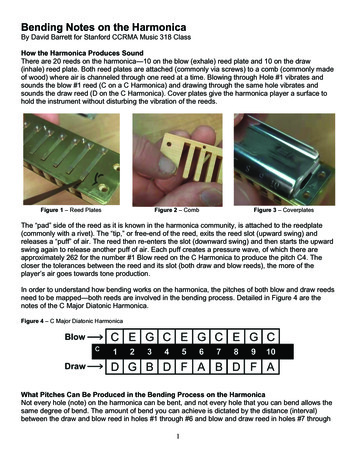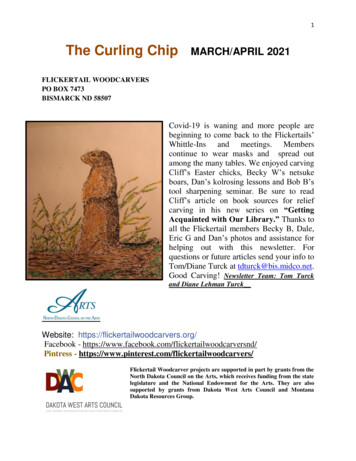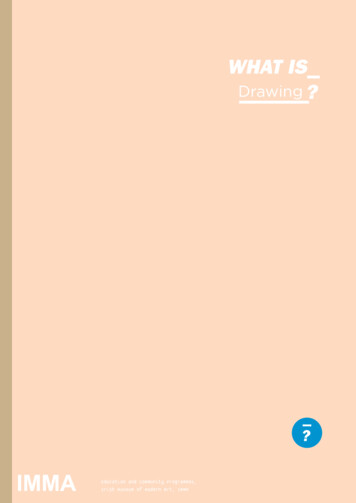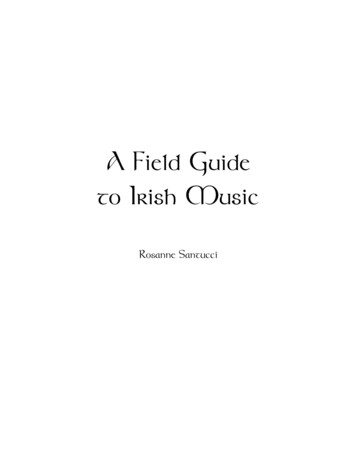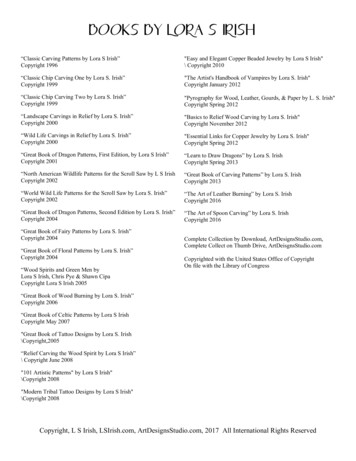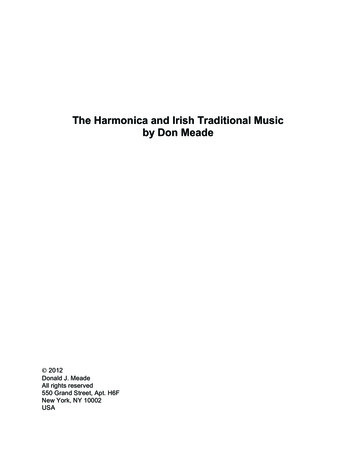
Transcription
The Harmonica and Irish Traditional Musicby Don Meade! 2012Donald J. MeadeAll rights reserved550 Grand Street, Apt. H6FNew York, NY 10002USA
TABLE OF CONTENTSINTRODUCTION3WHAT KIND OF HARMONICA?4TECHNICAL TIPS13MAJOR, MINOR, MODAL16ORNAMENTATION18CUSTOMIZING AND MAINTAININGCHROMATIC HARMONICAS21Appendix A: IRISH HARMONICA DISCOGRAPHY26Apendix B: MODE AND POSITION CHART32Appendix C: HARMONICA HISTORY332
INTRODUCTIONThe name “harmonica” has over the yearsbeen applied to a variety of musicalinstruments, the earliest of which wasprobably an array of musical glassescreated by Ben Franklin in 1761. The 19thcentury German-speakers who invented themouth-blown free-reed instrument nowknown as the harmonica originally called it aMundharmonika (“mouth harmonica”) todistinguish it from the Handharmonika oraccordion. English speakers have sincecalled it many things, including the mouthorgan, mouth harp, French harp, Frenchfiddle, harpoon, gob iron, tin sandwich andMississippi saxophone. “Mouth organ” is themost common name in Ireland, where“harmonica” is often used only to refer tochromatic models.influenced by the way in which song airsand dance tunes are played on instrumentswith a longer history in the country, havedeveloped their own distinctive techniquesand styles.Instrumental technique is not really the keyto playing Irish traditional music. Anyonewho has ever heard a classical violiniststiffly bow through a fiddle tune willunderstand that technical competencecannot substitute for an understanding oftraditional style. That understanding canonly be acquired by listening to andemulating good traditional players. If youwant to play Irish music, you should listen toas much of it as possible. Listen especiallyto music on the uilleann pipes, fiddle andflute, the most important vehicles for Irishtraditional music for centuries and theinstruments on which the foundations oftraditional style were built.There is a notable local mouth organtradition in south County Wexford, home tothe renowned Murphy family of Bannow, butthe instrument is quite popular throughoutIreland. It is, however, not usually regardedas highly by traditional music lovers as arethe closely related concertina and buttonaccordion. Many people still think of theharmonica as little more than a musical toy.If you can hum, lilt or whistle an Irish tune,you can learn to play it on the harmonica.The rest is just a matter of practice. Tryingto play a tune you don’t really know, even ifyou can read sheet music or follow a writtenpattern of blow and draw notes, is really alot harder than just playing by ear.The tin whistle once suffered from a similarreputation. In recent decades, however,Mary Bergin and other virtuoso players havebrought the once-humble whistle to theforefront of the Irish musical tradition. Theharmonica is overdue for a similar reevaluation. Recordings by the Murphys,Eddie Clarke and other top Irish playersprovide convincing proof that the mouthorgan is fully capable of conveying all thebeauty and subtlety of Irish traditional airsand dance tunes.You don’t need formal lessons to play Irishmusic on the harmonica. Trial and error willbe your best teacher. Once you have a tunein your head, just try to play it. The moreyou play, the more you will understandabout the structure and patterns of Irishtunes, and about the harmonica itself. Andthe more tunes you learn, the easier itbecomes to pick up new ones.Before attempting to play jigs and reels, youshould start by playing slower song airs,marches and waltzes. These tunes providean opportunity to build up your lip muscles,work on breath control and tone, andgenerally figure out how the harmonicaworks. Not to mention that a completetraditional musician must be able to playslow airs as well as fast dance tunes.How to Learn Irish MusicThe harmonica was designed to play andaccompany simple major-key Europeanmelodies. The instrument has proved to besurprisingly flexible, however, and ingeniousmusicians from China to the American southhave found novel ways to play very differentstyles of music on it. Musicians in Ireland,3
When you acquire enough proficiency tomove on to livelier tunes, keep in mind theimportance of a steady tempo. If you haveto slow down to play a difficult passage in atune, you're playing the rest of it too fast. It'sbetter to play slowly but at a consistenttempo. If you can play fast, it doesn't meanthat you have to do so all the time. No onewould try to sing every song they know asquickly as possible, but too many musicianstake that approach to dance tunes. Stick toa tempo at that lets you put someexpression into the music.or hole can sound reeds for two differentnotes. If you press or blow you get onenote, but if you draw out you get another.This in-and-out pattern imparts a naturallybouncy rhythm to the music and explainswhy single-action instruments are the freereeds of choice for Irish dance tunes.On both the button accordion andharmonica (but not on the concertina), thenotes of the scale are lined up in one row.Moreover, the tuning of chromaticharmonicas, which will be discussed below,is much like that of Irish-style two-rowbutton accordions. Because of thesesimilarities, harmonica players can oftenadapt button accordion techniques to theirinstrument.Mouth Accordion?Fast-paced and highly ornamented Irishdance music is a challenging repertoire onany instrument. Harmonica players will findthat some of the typical melodic patternsand embellishments used by fiddlers, fluteplayers and pipers are difficult to reproduceon their instrument. While no Irish tune istotally impossible to play on the harmonica,some just don't fit it very naturally.That said, it must be pointed out that it tooka long time for the button accordion to beaccepted as a valid instrument for Irishtraditional music. Only when accordionistssucceeded in approximating the rhythm andornamentation used on more traditionalinstruments did the “box” come into themainstream of Irish music. Harmonicaplayers can profit by their example.Some tunes are awkward on otherinstruments too. Flute players and pipersoften alter fiddle tunes to make themplayable on their instruments, and it is arare button accordionist who is comfortableplaying in all the keys used by fiddlers. Youshouldn't give up without a struggle, but ifre-phrasing a passage or changing the keyallows you to play music that is otherwisefiendishly difficult, you don’t have to beashamed to do so.WHAT KIND OF HARMONICA?There are several distinct types ofharmonicas. It is possible to play Irishtraditional music on all of them, and eachhas its own advantages and disadvantages.Standard Diatonic HarmonicasThe diatonic harmonica is by far the mostcommon variety. The most popular version,often referred to as a “Richter” harmonica(see appendix on harmonica history) is asmall instrument with 10 holes, each ofwhich contains a blow reed and a drawreed. Most diatonics have a single reed foreach note but some have two, which maybe tuned slightly apart in order to produce awavering “tremolo” effect or an octave apartfor a “full concert” sound. All diatonicharmonicas have reeds only for the notes ina single major (do-re-mi.) scale – they arelike pianos with no black keys.Irish harmonica players can take someinspiration from players of other free-reedinstruments used in the Irish tradition. Theharmonica has a lot in common with thebutton accordion and “Anglo-German” styleof concertina, both of which have a longhistory of use by Irish musicians. All threeare “single-action” free-reed instruments.On a double-action instrument like the pianoaccordion or “English” concertina, the samenote sounds on both the press and draw.On a single-action instrument, each button4
STANDARD 10-HOLE DIATONIC HARMONICAKey of CBlow reeds shown in upper case, draw notes in lower case; available “bent” notes in italics1Cdc#234EgGbCdf- f#g# - a#c#56EfGa7bC8910D#F#A#-BDEfGaCg#The scale used on a diatonic harmonica canstart on any one of the twelve notes used inWestern music. Standard diatonicharmonicas are available for all twelve,some in both high- and low-pitchedversions. The harmonica is classified by thenote on which the scale starts. If do is C, theharmonica is in the key of C.scheme was designed to make it possible toplay a simple two-chord accompaniment tomajor-key melodies.Some of the missing notes can be played by“bending” other notes. We’ll return to thesubject of bending below, but even with thataid, the standard 10-hole diatonic’s tuningscheme sharply limits its usefulness for Irishtraditional music.A typical ten-hole diatonic like the HohnerMarine Band has a range of three octaves,but the only complete octave starts with theblow note in hole 4. To play this scale, youfirst blow into and then draw from hole 4,then repeat this in holes 5 and 6. To finishthe scale, you must reverse breath directionin hole 7, first drawing and then blowing.The reversal of breath direction ensures thatthe next octave also starts on a blow note.Extended Range DiatonicsLonger standard diatonics give more scopefor solo melody playing, as they extend therange of notes above the gapped scale inthe first three holes. If you stick to the rightside of the longer diatonics, all the notes inthe scale are available. The same drawbends are available as on the 10-holeinstrument, and there are a few more blowbends in the highest holes.The high octave that starts with blow 7 lacksthe 7th note (ti) in the scale. The pattern ofblow and draw notes also changes in thisoctave, where the draw notes are the lowerof the two notes in each hole. In the middleoctave, do and re are blow 4 and draw 4.But in the high octave, blow 7 is do whiledraw 8 is re.As with the 10-hole diatonic, the draw notesare in different positions relative to theadjacent blow notes in each octave. This isvery apparent in the extended high range,where in order to play a C major scale on aC instrument it is necessary to skip from 10blow to 12-draw to 11-blow to play C, D andE in sequence. Hohner’s Marine Band M364and M365 are the most easily availableextended-range diatonic models. The 12hole M364 is available in C, D and G, andthe 14-hole M365 only in C and GThe standard harmonica’s low octave startswith the blow reed in hole number 1 but thescale is missing fa and la, while so is both adraw note in hole 2 and a blow note in hole3. The reason for these gaps andduplications is that the low octave tuning5
12-HOLE HOHNER M364Key of C1Cdc#23Eg4Gbf - f#5Cdg# - a#6Ef7Gac#bC89101112D#F#A#-BC-DD# - F#dEfGACbEdGg#14-HOLE HOHNER M365Key of C1234CdEgGbCdc#f -f#g# -a# c#56EfGa7bC89D#F#dEfG1011A#-B C-DaCBE121314D#-F# F#-B A#-D#dGfCaEg#“Cross Harp” and Country TuningsThe standard 10-hole diatonic harmonicacan be used to play Irish tunes, but it ismost favored by blues players, who makeup the largest segment of the harmonicaplaying public. Blues stylists, however, donot usually play in the key in which theharmonica is tuned, preferring the “crossharp” or “second position” scale, whichstarts on a note pitched a fifth higher, i.e. soinstead of do. In the C scale, so is G, whichmeans the cross-harp scale on a Charmonica starts on G. So to play the bluesin G, you use a C harmonica.when playing on a C harmonica. In additionto providing this “blue” note, cross harpshifts important notes in the scale to lowdraw reeds that can be easily “bent” tosound notes the harmonica wasn’t designedto play at all. In the low octave, a cross-harpscale starts with 2 draw (or 3 blow, which isthe same note) but you have to bend 3 drawdown a whole step to play the second noteof the scale.Bending, which will be discussed in moredetail below, is one way to play missingnotes on a diatonic harmonica, but “countrytuned” diatonics provide another solution.These are standard ten-hole diatonics onwhich one or more reeds have been retunedso that you can play a complete two-octavemajor scale in the cross-harp position.A complete cross-harp scale starts with theblow reed in hole 6. The seventh note in thisscale is half a step lower (flatter) than in themajor scale, e.g., F instead of F# (F sharp)6
SIMPLE COUNTRY TUNING – SHARPENED 5 DRAWAltered C harmonica1Cdc#2Egf- f#34GbCdac#56E f#*Gaf7bC89D#F#DEFG10A# - BACg#Irish tunes set in the “mixolydian mode”(more on modes below) use a blues-likescale with a flattened 7th interval, and forthese the cross-harp position on a regulardiatonic works well. You can also play atrue major scale in the cross-harp position ifyou start with the blow reed in hole 6, butyou need to play a blow bend in hole 9. Ona C harmonica, this is a G major scale withF# instead of F. But you can’t play a Gmajor scale in the octave that starts withdraw 2. You can bend draw 3 down tosound A, but there is no bend that will giveyou an F# in the 5 draw hole. This isbecause bends are only possible if thepitches of the two reeds in a hole are offsetby at least a whole tone, and the differencebetween E and F is only a half tone.currently available on the Seydel “bluesfavorite country” model.Another variation on standard tuning wasinvented by New Zealand harmonica aceBrendan Power. In this tuning, which hecalls “Paddy Richter,” the 3 blow reed istuned up a whole step (e.g., from G to A ona C harmonica). Low octave draw bendsare still available but it’s easier to play Irishmelodies in the cross-harp position withouthaving to bend. The draw note in hole 5 isstill unbendable, however, so you still can’treally play major-key melodies in cross-harpposition in the middle octave unless youuse the advanced “overblow” techniquepioneered in recent years among bluesstylists by genius diatonic player HowardLevy. But that’s a technique beyond thescope of this pamphlet.One way to play major melodies incrossharp position (and still be able to throwin a lot of bluesy bends) is to retune the 5draw reed, sharpening it up a half step to F#on a C instrument (see the asterisked noteabove). With a combination of bent notesand this one retuned reed, you can play atrue major scale in crossharp position in twodifferent octaves. If you start with the Gdraw reed in hole 2, you have to play a drawbend in hole 3 to sound A. If you start thescale with the G blow reed in hole 6, youhave to play a blow bend in hole 9 to soundF#. Rick Epping, the first American to winthe All-Ireland mouth organ championship,has made good use of this tuning, which isAn even more sophisticated “country” tuningis used on the Lee Oskar Melody Maker andHohner “Country-tuned” Special 20 models.This scheme raises the 5 blow reed a halfstep, as in simple country tuning, and the 3blow a whole step, as in “Paddy Richter.”But it also raises the 9 draw reed a halfstep. With these three alterations (shownwith asterisks on the chart below), you canplay a complete major scale over two wholeoctaves, starting with draw 2, without havingto bend any notes.Country-tuned harmonicas are usually7
“PADDY RICHTER” TUNINGC harmonica with sharpened 3 blow reed1Cdc#2Egf#/f34A* bCda#c#56EfGa7bC8910D#F#B/A#DEFGaCg#FULL COUNTRY (“MELODY MAKER”) TUNINGC harmonica with three altered notes123456789D#Cdc#Egf#/fA* bCda#c#E f#*GafBCdE10B/A#F#* GACg#labeled in the cross-harp key (G for a Charmonica). But as the chart above shows,a “G” Melody Maker is really just a standardC instrument with three altered notes.draw note sequence familiar to cross-harpplayers and continue to bend notes, butyou’re not stuck with the flattened seventhof the blues scale.This tuning is popular with Nashville-stylecountry musicians who want to apply bluesybends to major key melodies. Irish singerand bouzouki ace Andy Irvine has alsomade great use of Melody Makerinstruments in this way. The best exampleof applying this tuning scheme to Irishdance tunes without relying on bent notes isGalway native Paul Moran’s playing on FirstFlight, a 2002 duet recording with fiddlerFergal Scahill.Tremolo DiatonicsTremolo harmonicas have two reeds foreach note, one on the top plate and one onthe bottom. In these instruments, unlikestandard “Richter” harmonicas, blow anddraw reeds are on the same reedplate, butnot in the same holes. Each reed is isolatedin its own chamber. The top and bottomplates have an identical tuning scheme, butthe reeds on each are tuned with a slightoffset in pitch to create the wavering tremoloeffect. This design was invented by WilhelmAnton Thie in Vienna and is known as theWiener or Thie system.Country-tuned harmonicas might appeal toanyone who has played a lot of blues “harp”before attempting to tackle Irish traditionalmusic. You can stick with the blow-and-Some Wiener tremolos, including Hohner’s8
“ORIENTAL” TREMOLO DIATONIC HARMONICAKey of C1Gd23456789101112CfEaGbCdEfGabCDEFGaCbEComet models, have the two reedplatestuned an octave, rather than just slightly,apart. This is a different sort of tuning thanthat used on so-called Knittlinger-systemharmonicas like the Hohner Auto-Valve orMarine Band “full concert,” which have thetwo reedplates tuned an octave apart butstill use the Richter system of having a blowand draw reed in each hole on each plate.using equal temperament . As free-reedwizard Rick Epping has noted, thesedifferences make Oriental tremolos moresuitable than European models for melodyplaying.Oriental tremolos are also quiteinexpensive, So it's not surprising that thiskind of harmonica is the one mostcommonly played by traditional musicians inIreland, including the celebrated Murphyfamily of County Wexford and many-timeAll-Ireland champions Michael Conroy, NoelBattle and Austin Berry. At a fleadh cheoilmouth organ competition, most musicianswill be playing Oriental tremolos. Otherdiatonic instruments are allowed butchromatic players have been exiled to the“miscellaneous instruments” competition.Most European-made tremolo instruments,including Hohner’s Echo models, use thesame tuning scheme as standard Richterdiatonic harmonicas, with the first threeholes set up for chord playing. Thesemodels are also usually tuned using “just”intonation, in which the chords sound purebut the intervals between notes deviateslightly from the “equal” intonation used onmost modern instrumentsIt used to be hard to find Oriental tremolomodels in the U.S. in keys other than C butHohner now imports the Echo Celeste in all12 keys. Some Suzuki and Tombo tremolosare also made in all keys, but they are notsold in the U.S.The tuning scheme used for most tremoloinstruments made in the Far East (shownabove) is diffferent. It is similar to that ofextended-range Richter diatonic andtremolo instruments. But in place of thechordal accompaniment setup in the firstthree holes, there is a full four-hole lowoctave with no missing notes in the scale.The middle and high octaves have the sametuning pattern as Richter diatonics but areshifted one hole to the right, starting withblow 5 instead of blow 4.One interesting effect possible on tremoloharmonicas is to play on only one of the tworeeds in each hole. The player can thenswitch to playing both, as when a buttonaccordionist changes the coupler setting toget a fuller sound. You can do this bycovering either the lower or upper reedholes with your lip and playing only from thetop or bottom. Antrim tremolo ace KieranMcHugh did this on his 1980’s cassetterecording.There is a smaller pitch offset between thetwo reeds for each note on Orientaltremolos, which gives them a “drier” soundthan European models. They are also tuned9
Despite the traditional pedigree of Orientaltremolos, they don’t suit all Irish-styleplayers. Many harmonica players don’t likethe tremolo effect at all. And cross-harpstylists looking for bluesy effects will findthey can’t bend notes on a tremolo.blow and draw notes is the same in everyoctave. The first octave starts with the blowreed in hole 1 (do) and finishes with theblow reed in hole 4 (again do). But the nextoctave starts with the 5 blow reed, which isalso do. The same pattern is repeated in thenext octave, with both 8 and 9 blowsounding do.Solo-tuned DiatonicsOriental tremolos are sometimes called“solo-tuned” because they don’t have anymissing notes in the diatonic scale. A truesolo-tuned diatonic is a different sort ofharmonica designed so that the pattern ofDoubling up the “tonic” (do) note makeseach octave a standardized four-holemodule in which the sequence of blow anddraw notes is the same. There is no needSOLO-TUNED DIATONIC HARMONICAKey of C1Cd2Ef345GabCCd6Efto learn a separate tuning pattern in eachoctave. The player does still have to acquirea feel for which do reed he or she is playing.4 and 5 blow are both do, for example, but 4draw sounds mi (half a tone lower) while 5draw sounds re (a whole tone higher).789GabCCd10Ef1112GabCharmonicas. These prevent air from passingaround reeds that aren’t being sounded andmake for better tone and volume. TheHering is also cheaper than the Hohner orSeydel models.Solo-tuned tremolo models are made byHohner, Seydel and Huang. Most areavailable only in C, but Seydel’s high-endFanfare models are made in D, G, A and Bflat. Except by custom order, non-tremolo,solo-tuned diatonics are available only inthe key of C. That’s fine if you’re playing inC or related scales, but awkward if you wantto play Irish tunes in the usual keys. Thebest reason to play these instruments is thatthe same tuning scheme is used inchromatic harmonicas, so playing the solotuned diatonic makes for an easy transitionto the bigger instrument.Solo-tuned diatonics include the ChineseHuang Cadet Soloist, the Brazilian Hering8024 Master Solo, the German SeydelSolist Pro and Hohner’s Chinese-madeMelody Star and Czech-made Marine BandSoloist (model M3640). The Huang is a lowquality instrument that goes out of tune assoon as you start playing it. The MelodyStar is a cheap, 8-hole instrument for schoolchildren. The Marine Band model producesa mellow tone and has long-lasting reeds,but the lowest notes are weak because ofair loss through the reed slots. The Seydelis better on air loss but the reeds are not aswell tuned. On the air-tight, well-tuned,plastic-bodied Hering, the first five reedslots are covered by plastic “wind-savingvalves” of the type used in chromaticChromatic HarmonicasIf a diatonic harmonica is like a piano withonly white keys, the chromatic harmonicasupplies the black ones. It is “chromatic”10
because it includes all the colors of themusical rainbow. First marketed by Hohnerin 1910, the chromatic is really two solotuned diatonic harmonicas in oneinstrument.respect the chromatic harmonica is verysimilar to an Irish-style two-row buttonaccordion. To switch between the sets ofreeds, the player presses in a springmounted slide on the right side of theharmonica. The slide allows air to pass overonly one set of reeds at a time. Pressing itin while playing a single note will raise thepitch by a half tone (that's the same as theinterval between mi and fa or between ti anddo in the diatonic scale).The reed plate on top has blow and drawreeds for one key, while the plate on thebottom has blow and draw reeds for adifferent key pitched half a tone higher (e.g.,C on top, C sharp below). This combinationincludes all the notes of every key. In thisCHROMATIC HARMONICAKey of C123456789101112C dEfG ab CC dE fG ab CC dE fG ab CC# d#F f#G# a#c C#C# d#F f#G# a#c C#C# d#F f#G# a#c C#Chromatic harmonicas come in differentsizes and can have from 8 to 16 holes. Toplay a particular note, the player must knowwhich hole to play, whether to blow or draw,and whether it's necessary to press theslide. There is a price to be paid for havingreeds for every note. Some chords availablein the usual diatonic tuning scheme cannotbe played on a chromatic. The chromatic’sreed slots are also covered with plastic“wind-saving valves.” These flaps preventair loss through blow reed slots whenplaying draw reeds (and vice versa), butthey also make it impossible to really bendnotes or get that lonesome, bluesy wail thatfor many people defines the sound of theharmonica. In general, it is not possible toget as strong and gutsy a tone on anychromatic as it is on a small diatonic.of C. In practice, however, some keysrequire extensive use of the slide and arevery awkward on the C harmonica,especially when one is playing fast-paced,highly ornamented Irish dance music. Eventhe most accomplished classical playersconcede that “flat keys” like F and B flat areeasier on the C harmonica than the “sharpkeys” like D and G common in Irish music.Another problem with the purely chromaticapproach is that the chords available on theC chromatic really only work for melodiesset in C major or in some of the modalscales that use the same array of notes(more on chords and modes below). So ifyou’re playing in G on a C chromatic, forexample, you won’t be able to play a Gchord and playing C blow chords will clashwith the melody.Theoretically, a single chromatic instrumentcan be used to play in any key. Classicaland jazz harmonicists do, in fact, play thisway, so the most expensive professionalquality instruments are only made in the keyOne excellent chromatic harmonica for Irishmusic is the 10-hole, wooden-body HohnerChromonica 260, available in the keys of Gand C. The G instrument has the same11
range as “first position” on the fiddle, fromlow G to a high C. It is a perfect instrumentfor playing tunes in G major and relatedmodal scales, and can be played in crossharp position for tunes based on a D scale.The Chromonica 260 in C can be used incross-harp position to play tunes in G orrelated modal scales, but playing in D on aC chromatic is awkward.experience with Seydel instruments boughtin this country is that they are likely to beout of tune when delivered, even before youplay them.Many other chromatic models are availablefrom Huang, Suzuki, Miwha, Tombo andLark. Be aware that the Hering “blueschromatic” and “Vintage 40,” as well asHohner “Koch” and “slide harp” models arechromatics with the same pattern of missingnotes in the first three holes as a standarddiatonic instrument.Hohner also makes other chromatic models,including the 12-hole SuperChromonica270 and the more expensive, plastic-bodiedCX-12. Both of these are available in allkeys, including D, which is particularlyuseful for Irish music.Other Tuning SchemesThere are many other harmonica tuningsystems besides those shown in the chartsabove. The Lee Oskar line includes diatonicharmonicas in “major 7th” (all the F’s on a Cdiatonic tuned up to F#), harmonic minor (allthe E’s and A’s on a C diatonic tuned downto D# and G#) and natural minor (all the E’sand B’s on a C diatonic tuned down to D#and A#). Seydel will fill orders for virtuallyany tuning scheme a customer can devise.The Brazilian-made, 12-hole Hering 5148,7148 (a slightly better version) and low-C“Baritono” 6148 models are excellent forIrish music. The Herings have manyadvantages over the Super Chromonica.They’re cheaper, for one thing, and thetightly sealed plastic body allows very littleair leakage. The reeds are more flexible,blowing and drawing more easily as well.Hohner’s Steve Baker model is a 12-holediatonic instrument that, instead of adding ahigher range of notes to the normal 10-holelayout, applies the gapped-scale tuningnormally used in holes 1 through 3 toanother, lower set of three holes. Thissacrifices the highest notes to provide moreof the low-end draw bends preferred byblues and country stylists.Disassembling and repair is easier with theHering instruments as all parts are heldtogether with screws rather than the tacksused on Chromonicas. The holes on themouthpiece are round rather than square,and the lack of corners seems to trap lessgunk. The mouthpiece projects out fartherfrom the body, which some players prefer tothe flatter-faced Hohner design. The reedshave a brighter, more metallic timbre thanthe mellower Hohner sound. On the downside, Hering reeds go out of tune quickly,especially on the low-pitched D instrument.“Valved” diatonics are made by fitting windsaving valves (little plastic strips) on drawreeds 1 through 6 and blow reeds 7 through10. This prevents air leakage as well as theusual sort of blues bending. It does,however, allow for a choked sort of bend tobe played in all holes. Examples includethe Suzuki Promaster Valved.Seydel makes chromatics in three ranges ofquality. Their DeLuxe 12-hole model isavailable in “Irish tuning” (B/C and F#/G)and they can also make a C#/D model onrequest. These tunings are extremely usefulwhen you start trying to use the slide forornamentation, for reasons that will bedescribed below. Seydel instruments soldin the U.S. seem to be assembled here fromimported parts. Unfortunately, my ownA new type of harmonica invented by RickEpping, the Hohner “Extreme Bending” XB40, adds extra reed chambers to thestandard ten-hole diatonic instrument sothat all notes, not just the usual ones, canbe bent a full tone lower.12
Where to Get a HarmonicaHohner standard diatonic instruments arewidely available in retail music stores.Other types of Hohner instruments, andvirtually all non-Hohner harmonicas, aremost easily ordered these days from onlinevendors.A partial B minor chord (B and D) can besounded by drawing from holes 3 and 4 orfrom 7 and 8, and a partial F major (F andA) in holes 5 and 6 or 9 and 10. Thesesame chords are also available, in slightlydifferent positions, on Oriental tremolo, solotuned and chromatic instruments (see thecharts above).Harp Depot, an online business based inOhio, is a good source for for chromaticsfrom Hering and other makers. Seydel’swebsite (www.seydel1847.de) is extensive,and allows easy ordering of custom-tunedinstruments.On the standard C diatonic, but on no othertype of C harmonica, a G major chord(G,B,D) is produced by drawing on holes 1,2 and 3 or 2, 3 and 4, and a G7 chord(G,B,D,F) by drawing on holes 2, 3, 4 and5. The gaps in the low octave scale in the“Richter” tuning scheme were designed tomake these “dominant” and “dominant 7th “chords available, thus providing basic twoch
traditional music for centuries and the instruments on which the foundations of traditional style were built. If you can hum, lilt or whistle an Irish tune, you can learn to play it on the harmonica. The rest is just a matter of practice. Trying to play a tune you don’t really know, even if you can read


